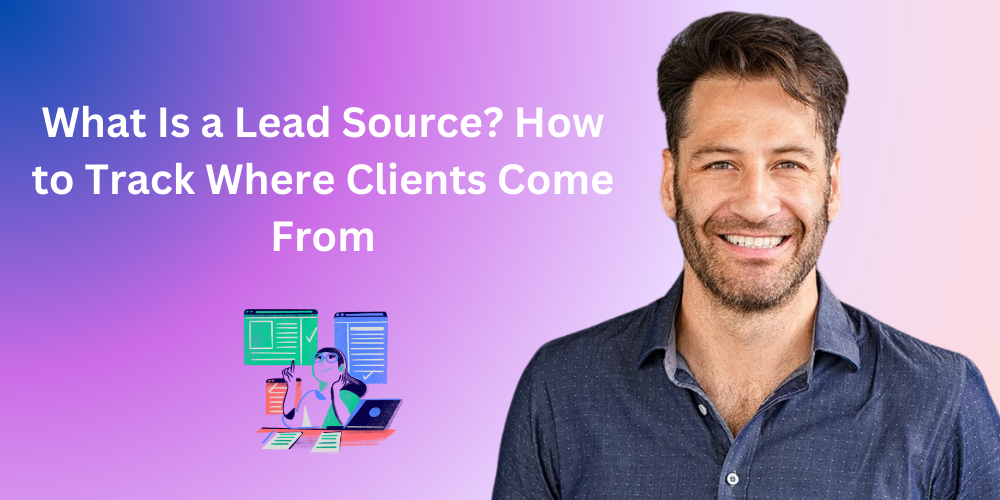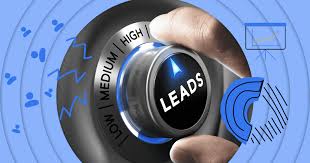What Is a Lead Source? How to Track Where Clients Come From

Let's face it—clients aren't magical unicorns that just wander into your business and shower you with money. (If they do, please share your secret!) In reality, finding and keeping clients boils down to one critical thing: lead sources.
But wait—what exactly is a "lead source," and why does it matter to your business? Sit tight, grab a coffee (or tea, no judgment here), and let's break this down.
What's a Lead Source?

Simply put, a lead source is any channel or method that brings potential customers your way. Think of it like a fishing rod—different bait catches different fish, right? Your lead sources are the bait, attracting potential customers interested in what you're offering.
Let's say you're crafting handmade jewellery. Your lead sources might be Instagram ads, local artisan fairs, or even a feature spot on a morning talk show (fancy, right?). These methods introduce your brand to people who might never have stumbled across you otherwise.
But remember, a lead isn't just someone casually browsing your website while binge-watching Netflix. They're folks who've shown genuine interest—like signing up for your newsletter or downloading your e-book. They're warming up, and it's your job to keep them engaged.
Why Do Lead Sources Even Matter?
Not all leads are created equal—shocking, I know! Some lead sources are absolute goldmines, while others might just drain your wallet faster than your last vacation did.
Here's why the right lead sources are crucial:
1. Quality Beats Quantity, Every Time

It's tempting to chase after loads of leads, but here's the reality check—100 lukewarm leads aren't worth as much as 10 red-hot ones. High-quality leads actually want what you're offering and won't waste your precious time playing email ping-pong without ever buying.
2. The Safety Net Factor (AKA, Don't Get Stuck)
Imagine you're relying entirely on word-of-mouth. Sure, it's fantastic until Aunt Karen has a bad day and stops sending referrals your way. Always have multiple reliable sources. Diversifying your lead channels is like having multiple parachutes—smart and potentially life-saving (for your business, at least).
3. Scalability (Because Growth Shouldn't Hurt)
Your favourite lead source today might not handle your booming business tomorrow. Choose scalable lead sources—ones you can dial up when you're ready to conquer the world.
4. Build Your Brand Equity
Some lead sources, like webinars or content marketing, might not instantly flood your inbox with leads. But they're building something equally valuable—your brand's reputation. Remember, a strong brand today means easier leads tomorrow.
5. Keep an Eye on Your Cost Per Lead

A good lead source shouldn't just attract potential customers—it should do so without bankrupting you. You might love the idea of TV ads, but if they're costing you thousands per lead, maybe reconsider. Track your costs closely and focus on sources giving you the best bang for your buck.
Types of Lead Sources You Need to Know (And Actually Use!)

Alright, you've got the basics. Now, let's talk specifics. Not all leads walk into your inbox already warmed up and ready to buy—wouldn't that be nice? Instead, leads come in different flavours.
Let's explore the most common (and effective) types.
1. Word-of-Mouth Leads (Your Secret Marketing Army)
There's nothing better than customers who rave about you. Seriously, they’re like unpaid brand ambassadors who tell their friends, family, and even random strangers on the bus how amazing you are. These leads are golden because trust is already baked in.
2. Referral Leads (Your Customers' Friends)
Referral leads are like word-of-mouth’s close cousins. Instead of just personal connections, these come from professional recommendations, online reviews, or social media shoutouts. Think of them as the "trusted friend recommendation" leads, just digitally enhanced.
3. Cold Leads (Ice, Ice Baby)
Okay, these are folks who've shown some interest—maybe they downloaded your free guide or subscribed to your newsletter—but they're not exactly pulling out their wallets yet. Cold leads require nurturing, patience, and a steady supply of great content to warm them up.
4. Hot Leads (Ready, Set, Buy!)
Hot leads are ready and eager to make a purchase. They might've reached out directly, clicked on a targeted ad, or responded to a personalized offer. Honestly, they're every marketer’s dream date—no games, just straight to the sale.
5. Geographic Leads (Location, Location, Location)
These leads are location-specific, perfect if you're running a local café, boutique, or service. They're nearby, they’re convenient, and they're already in your community—so your message lands exactly where it counts.
6. Social Media Leads (Because Facebook Isn’t Just for Cat Videos)
Social media isn't just scrolling endlessly through memes and funny videos (although, we’re guilty of that too). It's an incredible place to find potential customers. Regularly sharing engaging content can turn casual scrollers into loyal customers.
Practical Lead Source Examples (Steal These Ideas!)

Here are some amazing examples of lead sources:
- LinkedIn Connection Requests
LinkedIn isn't just a place to pretend you’re professional—it’s also a lead-generating powerhouse. Sending personalized connection requests (please, no generic invites!) can open doors to genuine conversations and, ultimately, sales.
Use tools like leadplay.io (because automation is your friend) to make this process efficient and effective.
- Facebook Ads
With almost 3 billion active users, Facebook isn't just huge—it's massive. And the targeting options? Chef’s kiss. You can precisely pinpoint your dream customers and put your ads right in front of their scrolling eyes.
Just remember to make your ads catchy, relevant, and always include a clear call-to-action (CTA).
How to Track Your Lead Sources

Great leads are awesome, but do you know what's even better? Knowing exactly where they come from! Here's the simple, stress-free way to track your lead sources so you can make smarter marketing moves.
Step 1: Choose Your Tracking Tool
It doesn’t have to be fancy—sometimes a good ol’ spreadsheet does the trick. But for easier automation and better insights, consider using customer relationship management (CRM) software. Popular options include HubSpot, Salesforce, or even something simple and user-friendly like Zoho.
Step 2: Be Consistent (Seriously!)
Everyone on your team must play by the rules. If Dave from sales doesn't log his leads properly, it's going to mess up your beautiful data. Make sure everyone knows exactly how to log leads—date, source, and contact details are must-haves.
Step 3: Assign Leads to Specific Sources
This part is crucial. Clearly marking each lead’s source—like "Facebook Ad," "Trade Show," or "LinkedIn Outreach"—helps you quickly identify what's working and what's just draining your resources.
Step 4: Regularly Review and Analyze Your Data
Numbers don't lie (unlike your scale after holiday dinners). Check your lead source data regularly. Look for patterns, spot what's performing well, and identify areas that need tweaking. Monthly check-ins are usually enough to keep things on track.
Step 5: Act on Your Findings
Data without action is just a waste of pixels. Share your insights with the team, adjust your strategies, and put your hard-earned data to good use. Celebrate your wins, fix your weak spots, and keep your marketing sharp.
Why Tracking Lead Sources Is a Game-Changer

Here’s why you really need to track those leads:
1. Gauge Marketing Success
You can't improve what you don't measure. Knowing exactly how many leads each marketing channel generates lets you clearly see what's delivering the best results.
2. Smart Budget Allocation

Stop throwing money at ineffective channels. If Instagram ads are costing you a fortune with minimal return, shift those funds elsewhere—like Google Ads or LinkedIn outreach, which might perform better.
3. Target Your Ideal Customer

Tracking helps you pinpoint which channels attract your ideal customers. If LinkedIn consistently sends you quality leads, invest more time there and less time in channels that produce "meh" results.
4. Optimize Your Sales Process

With clear lead tracking, your sales team knows exactly where to focus their efforts, making them more efficient and boosting overall conversions.
Lead Source Best Practices to Keep Your Pipeline Full

Alright, we've covered tracking. Now let’s wrap things up with some powerful best practices that'll keep your lead generation flowing smoothly.
1. Truly Understand Your Customer’s Journey
Think of your customer's journey like a Netflix binge session—each stage matters. Are they just discovering you (the pilot episode), researching options (mid-season drama), or ready to buy (season finale)? Tailor your messages to match each stage. A lead who's barely aware you exist needs different content than someone who's ready to swipe their credit card.
2. Diversify Your Lead Sources (Don't Put All Your Eggs in One Basket!)
Imagine relying only on one source, and it suddenly stops delivering—yikes! A healthy mix of online ads, email campaigns, social media, and offline channels like events or networking ensures you’re never left stranded. Think of your lead sources like your favorite snacks—variety is key to satisfaction (and success).
3. Always Be Testing (The ABCs of Marketing)
Just because something worked brilliantly last year doesn’t mean it'll keep working forever. Consumer behaviors change, new platforms emerge, and trends evolve. Constantly test new channels, strategies, and messaging. Stay agile, keep learning, and you’ll keep winning.
Wrapping It Up (The Big Finish!)
Here's the bottom line: knowing exactly where your clients come from—and how to attract more—is essential. By tracking lead sources meticulously, understanding their journey, diversifying your approach, and continuously testing, you'll build a powerful pipeline of high-quality leads.
Now go ahead, put these strategies into action, and watch your business grow. Happy lead generating!